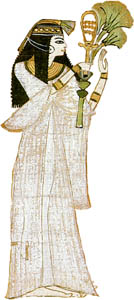

Sistrum
(sesheshet)
Appearance: The sistrum was a musical instrument formed as a sticklike wooden or metal object, with a frame and small metal disks that rattled when the instrument was shaken by hand. The head of Hathor was often depicted on the handle. The horns of the cow were also commonly incorporated into the design. The instrument produced a soft jangling sound resembling a breeze blowing through papyrus reeds.
Meaning: The sistrum was called shesheset by the ancient Egyptians and was a favored instrument in many religious ceremonies and rites, especially those associated with Hathor. The sistrum's basic shape resembled the ankh, the symbol of life and carried that hieroglyph's meaning. The Egyptian name of the sistrum, sesheshet probably derives from the sounds the instrument makes: a soft jangling sound resembling a breeze blowing through papyrus reeds. It was this sound that was supposed to placate the gods and goddesses. It is believed that the sistrum might have originated in the practice of shaking bundles of papyrus flowers (papyrus flowers were a symbol of Hathor).
Although the instrument eventually entered the cults of other deities (such as Amon, Bastet and Isis), it was with Hathor, her son Ihy and her attendants that the instrument is associated with in most representational contexts. The sistrum seems to have carried erotic or fertility connotations as well. This probably derives from the mythological character of Hathor.
The distinctive shape of the instrument is found in many contexts ranging from small mortuary objects to the columns of temples, such as those at the Temple of Hathor in Dendera.
Digg This!
![]() Del.icio.us
Del.icio.us
![]() Stumble Upon
Stumble Upon
